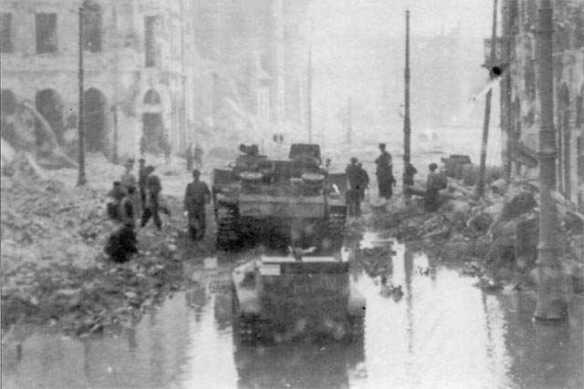Borgward B IV z Panzer-Abteilung 302.
Panzerabteilung 302 (Fkl), was a radio-controlled tank battalion that had 24 StuG III assault guns used as control vehicles and about 50 Goliath and B IV remote control demolition vehicles. The Goliath would prove particularly useful in destroying Polish barricades, but there were not enough to go around.
Several new weapons, specifically designed for city fighting after experience gained from the battle of Stalingrad, were sent to Warsaw. The Sturmtiger, an assault gun built on a Tiger tank chassis, was armed with a 380 mm rocket launcher that could fire high-explosive or shaped-charge rockets capable of demolishing a typical building or penetrating reinforced concrete structures. Two Sturmtigers were formed into Panzer Sturm-Morser Kompanie 1000 and fought in Warsaw from 1 9 – 2 8 August 1944. Warsaw also saw the first real combat use of the Sturmpanzer IV, an assault gun armed with a 150mm howitzer on a PzKpfw IV chassis. Ten Sturmpanzer IVs were formed into Sturmpanzer-Kompanie z.b.V. 218 and moved to Warsaw on 13 August.
As the Polish resistance lost its grip on the outer suburbs in Wola and Ochota, the insurgents were compressed into four main areas: Zoliborz , the Old Town, the city centre and Mokotow/Czerniakow. The AK [ARMIA KRAJOWA] also had a strong presence in the Kampinos Forest in the north and the Germans had been unable to isolate the city completely, so some personnel and supplies were trickling in from the outside. The Warsaw Uprising began to enter a new phase on 8 August, as it became clear to the Germans that they would have to reduce each section of the city in turn, with a series of deliberate attacks. Bach decided to finish mopping up Wola and adjacent areas in order to solidify the German hold over their thin corridor to the Bruhl Palace, then move in and crush the main resistance centre in the Old Town. Dirlewanger’s Kampfgruppe’, reinforced with 14 Hetzers and two Azerbaijani battalions, was ordered to consolidate the area around the Bruhl Palace and then continue all the way to Kierbedzia Bridge in order to restore German control over the Vistula crossings. Meanwhile, the Kaminski Brigade under Major Frolov was left to terrorize Ochota district, but Bach realized that the unit was incapable of conducting real city fighting. The next wave of German attacks would be spearheaded by Kampfgruppe Schmidt from the north and Kampfgruppe Reck from the west.
Oberst Schmidt’s group consisted of his own Sicherungs-Regiment 608, a heavy machine-gun platoon, a company of Panzer pioneers, a battery of 1.FH18 howitzers, as well as support from Eisb. Panzerzug 75. Major Reck, just arrived from the infantry school at Posen, was given two battalions of raw infantry recruits, a company of Azerbaijanis, an engineer platoon and a battery of Nebelwerfer. Both of these assault groups were very weak in reliable infantry and fire support and the only general support asset available was Panzerabteilung (Fkl) 3 0 2 with 23 StuG III assault guns and 36 radio-controlled demolition vehicles. Reinefarth, still in tactical control of the city battle, kept his less reliable Cossack and police units in reserve.
Schmidt’s troops entered the former ghetto from the north and encountered only light resistance, since there were no civilians in this devastated area and only a few Kedyw detachments. While some of his troops cleared the ghetto ruins, the bulk of his forces pivoted east and began attacking the west side of the Old Town but after two days of fighting their advance was brought to a halt. At the same time, Reek’s troops mounted a major effort to clear the Kedyw units out of the Jewish Cemetery and the north-west corner of Wola around the Kammler Factory. Radoslaw’s troops fought tenaciously for this area since it was one of the designated areas for Allied airdrops, but ultimately it was a misuse of some of the AK’s best troops to defend a non-critical area. Supported by Leutnant Klussmann’s Stukas and his Nebelwerfer, Reek’s forces pounded the area into rubble and inflicted significant casualties upon the Kedyw units. One of the captured Panther tanks was repeatedly hit by German anti-tank fire and had to be abandoned. By the time that Radoslaw decided to withdraw his troops before they were entirely encircled, Schmidt’s units had cut their escape route across the ghetto. Battalions Zoska , Miotla and Wacek finally managed to leave Wola on 11 August just before the German noose closed and escape across the ghetto in small groups towards the Old Town, but the Kedyw units were badly depleted in this pointless fighting. The last captured Panther tank led the Kedyw units along Stawki Street towards the west until it was immobilized by a hit from a German anti-tank gun; the Kedyw troops set it on fire and continued their retreat.
In Ochota, the two small A K units were not as hard pressed at the units in Wola and they were quick to sense the lax behaviour of the RONA troops operating in their district. When a large group of RONA troops were spotted looting several buildings in plain view of an AK-held strongpoint, the local AK commander decided to mount a counterattack. The RONA troops were caught completely by surprise and their commander, Major Frolov, was killed by a flame-thrower. After witnessing countless atrocities committed by these men, the Polish troops took no prisoners and annihilated a company-sized element of RONA . In less than a week of fighting, the Kaminski Brigade had lost over 500 of its 1,700 troops and accomplished nothing of military value. Eventually, the Germans brought up some pioneers to reduce the Wawelska and Kaliska redoubts. On 11 August, both buildings were attacked with Goliath demolition vehicles and the AK troops hurriedly evacuated their redoubts through connecting tunnels that had been dug to nearby sewer canals. Some troops succeeded in reaching the city centre, but at least two groups were eliminated in the sewers by German troops.
